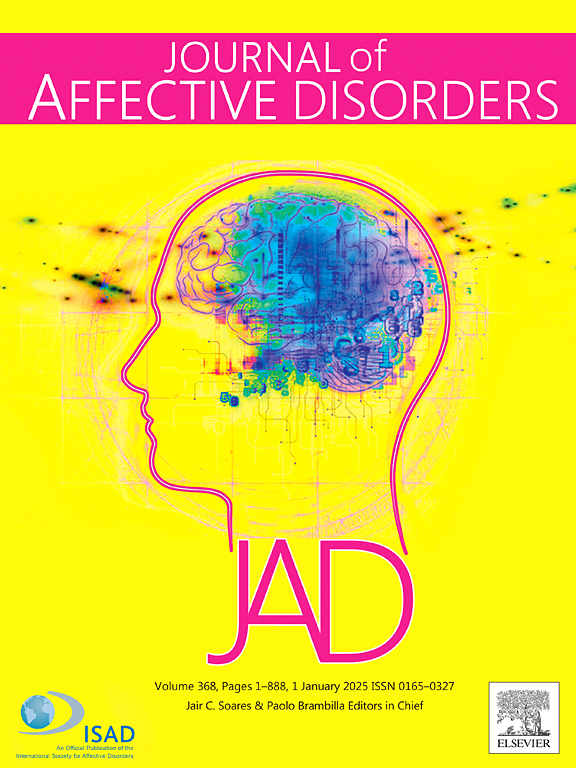中老年人多病十年轨迹与抑郁症状之间的关系:中国健康与退休纵向研究的结果。
IF 4.9
2区 医学
Q1 CLINICAL NEUROLOGY
引用次数: 0
摘要
背景尽管近几十年来慢性病与抑郁症状之间的联系已被证实,但有关多病共存与抑郁症状发生之间的时间动态关系的研究仍然很少:本研究纳入了中国健康与退休纵向研究(China Health and Retirement Longitudinal Study)中的 15,882 名中国中老年人,共 63,246 个观察指标。抑郁症状采用 10 项 CESD 量表进行评估,阈值设定为 12 分。研究采用基于群体的轨迹模型来考察多病发展轨迹。采用混合效应逻辑回归模型分析了抑郁症状的风险:在最终纳入的 15,896 名参与者中,37.6% 报告了多病状态,25.7% 发现了抑郁症状。在完全调整模型中,患有多病的人出现抑郁症状的可能性是普通人的 2.36 倍(2.24-2.49),每增加一种慢性疾病,这种可能性就增加 1.38 倍(1.36-1.40)。研究发现了四个不同的多病症轨迹组:无新病症组(32.6%)、缓慢增长组(42.9%)、稳定增长组(19.7%)和快速增长组(4.9%)。与无新条件组相比,其后三组出现抑郁症状的可能性更大,OR 分别为 1.53(1.39 至 1.71)、2.54(2.24 至 2.89)和 4.40(3.62 至 5.34):我们的研究结果凸显了多病累积对抑郁症状的重大健康影响,显示了风险与累积率之间的直接联系。我们呼吁关注多病人群的抑郁症状,以应对同时存在的身心健康问题所带来的重大医疗挑战。本文章由计算机程序翻译,如有差异,请以英文原文为准。
The association between the ten-year trajectory of multimorbidity and depressive symptoms among the middle-aged and older adults: Results from the China Health and Retirement Longitudinal Study
Background
Despite the established link between chronic conditions and depressive symptoms in recent decades, research into the temporal dynamics between multimorbidity and the occurrence of depressive symptoms remains scarce.
Methods
A total of 15,882 Chinese middle-aged and older adults with 63,246 observations from the China Health and Retirement Longitudinal Study were included in the present study. Depressive symptoms were evaluated using a 10-item CESD scale, with a threshold set at 12 points. Group-based trajectory modeling was used to examine the multimorbidity developmental trajectories. The risk of depressive symptoms was analyzed using mixed effect logistic regression models.
Results
Among the final included 15,896 participants, 37.6 % reported states of multimorbidity, and 25.7 % were detected as depressive symptoms. In the fully adjusted model, those with multimorbidity were 2.36 (2.24 to 2.49) times more likely to present depressive symptoms, and the likelihood increased 1.38 (1.36 to 1.40) times with each additional chronic condition. Four distinct multimorbidity trajectory groups were identified: no-new-condition group (32.6 %), slow growth group (42.9 %), steady growth group (19.7 %), and rapid growth group (4.9 %). Compared to the no-new-condition group, the likelihood of developing depressive symptoms was greater in the subsequent three groups, with ORs of 1.53 (1.39 to1.71), 2.54 (2.24 to 2.89), and 4.40 (3.62 to 5.34), respectively.
Conclusion
Our results highlight the substantial health effects of accumulating multimorbidity on depressive symptoms, showing a direct link between risk and accumulation rate. We urge focusing on depressive symptoms in those with multimorbidity to tackle the significant healthcare challenges arising from concurrent physical and mental health issues.
求助全文
通过发布文献求助,成功后即可免费获取论文全文。
去求助
来源期刊

Journal of affective disorders
医学-精神病学
CiteScore
10.90
自引率
6.10%
发文量
1319
审稿时长
9.3 weeks
期刊介绍:
The Journal of Affective Disorders publishes papers concerned with affective disorders in the widest sense: depression, mania, mood spectrum, emotions and personality, anxiety and stress. It is interdisciplinary and aims to bring together different approaches for a diverse readership. Top quality papers will be accepted dealing with any aspect of affective disorders, including neuroimaging, cognitive neurosciences, genetics, molecular biology, experimental and clinical neurosciences, pharmacology, neuroimmunoendocrinology, intervention and treatment trials.
 求助内容:
求助内容: 应助结果提醒方式:
应助结果提醒方式:


